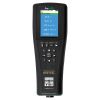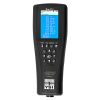YSI ProSwap 1-Port Cable Assemblies
Features
- Integrated temperature sensor with optional depth sensor
- Rugged twist-lock MS connector
- Includes probe guard and calibration/cleaning accessories
- Free ground shipping
- Expedited repair and warranty service
- Lifetime technical support
- More
Overview
ProSwap cables meet the needs of most water quality sampling applications with lengths ranging from 1 to 100 meters and 2.54 cm diameter. The ProSwap cable accommodates any single ProDSS digital smart sensor.
Digital Smart Sensor
Calibration information is saved in each smart sensor for an easy plug-and-play experience. Connect to a ProSwap or ProDSS handheld meter via the twist-lock MS connector to form a complete system. Options include:
- Conductivity/Temperature
- Optical Dissolved Oxygen
- pH
- PH/ORP
- Turbidity
- Total Algae-PC (Phycocyanin + Chlorophyll)
- Total Algae-PE (Phycoerythrin + Chlorophyll)
- Ammonium ISE
- Chloride ISE
- Nitrate ISE
Benefits
All ProSwap cables have a thermistor built-into the bulkhead for supplemental temperature readings and compensation. Additionally, an optional depth module is built-into the probe assembly. Cables include a non-reflective black plastic probe guard, storage sleeve, sponge, graduated cylinder for calibration, and maintenance kit (port plug, spare o-rings, tube of Krytox lubricant, syringe for depth sensor cleaning, and sensor installation/removal tool). A 4.9 oz weight and cable management kit is included with cables 4 meters and longer.
- (1) 1-port cable assembly with temperature sensor (depth sensor optional)
- (1) Black plastic probe guard
- (1) Storage sleeve
- (1) Sponge
- (1) Graduated cylinder for calibration
- (1) Maintenance kit (port plug, spare o-rings, tube of Krytox lubricant, syringe for depth sensor cleaning, and sensor installation/removal tool)
- (1) 4.9 oz weight and cable management kit (included with cables 4 meters and longer)
In The News
It’s Time to React to Water Quality: Proteus Multiparameter Probe aboard NexSens Buoy
Water quality monitoring is essential for safeguarding public health, protecting ecosystems, and ensuring the sustainability of water resources. Contaminants such as industrial pollutants, agricultural runoff, and sewage discharge can severely impact aquatic life and pose serious risks to human health if left unchecked. Traditionally, water quality monitoring has been a slow and labor-intensive process, requiring samples to be collected, transported to a lab, and analyzed—a process that can take days. However, with the advancement of real-time sensor technology, environmental agencies, researchers, and industries can now monitor water quality instantly.
Read MoreSafeguarding Communities with Real-Time Flood Monitoring in the City of Hazelwood
The City of Hazelwood is a suburb in St. Louis County, Missouri, home to around 25,500 people. Recently, the community has suffered increased flash flooding following severe storms, prompting the need for the installation of a flood monitoring system. In 2022, a NexSens X2 data logger was installed to monitor water level and rainfall in real-time, with the aim of reducing the loss of life and property as a result of extreme weather events. [caption id="attachment_39411" align="alignnone" width="940"] The latest flood event at Coldwater Creek, where the water level rose by 14 feet, exceeding the height of the X2 by three feet. The sensor can be seen behind the wall that usually contains the Creek.
Read MoreSave our Bogs! Culture, Conservation and Climate Action in Ireland’s Peatlands
Characterized by long-term accumulation under waterlogged conditions, peatlands exist on every continent and account for 3-4% of the global land surface . Small but mighty, these often overlooked wetland environments are estimated to hold as much as one-third of the world's organic carbon in their soil—twice the amount found in the entirety of the Earth's forest biomass. While healthy peatlands can trap and store carbon, regulate water, and provide important habitats for rare species, human alteration has disturbed peatland carbon and nitrogen cycles on a global scale. Approximately 12% of the world’s peatlands have been drained and degraded through conversion for agriculture, forestry, infrastructure development, and other uses.
Read More

































